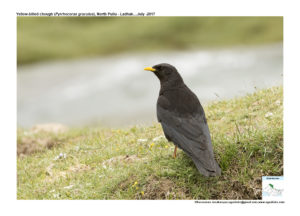Alpine-chough

Alpine Chough Pyrrhocorax graculus
Etymology :
- Pyrrhocorax : purrhos -flame-coloured, red; korax – raven
- Graculus : Jackdaw
Distribution in India: Breeds in Himalayas, winter visitor in foothills of Himalayas and North East India
Description: Size of 34–38 cm; Wt. of male 194–277 g, female 160–254 g. It is a medium-sized, relatively small-headed corvid with fairly long tail, short bill slightly decurved. In flight it has a, rather broad wings with “fingered” primaries, trailing edge of wing gently S-shaped ; flight often gamboling in updrafts of air over sheer cliff faces and ridges, swooping and diving, soaring and sweeping down slopes. The nominate race has entire plumage black, weakly glossed bluish-green, most strongly on wings and tail; iris is dark brown; bill is lemon-yellow; legs are bright red. .Both the sexes are similar. The juvenile has plumage that is dull sooty black, bill is dull horn-coloured, legs are black or dark brown, legs becoming red during first winter. Races differ in size and in relative toe and tarsus lengths, nominate race smallest: forsythi is largest; digitatus is intermediate.
Habitat: Found in High-altitude mountain pastures with rocky crags above tree-line, descending into upper valleys in winter. Seen from 3500-5000 meters in Himalayas
Food Habits: It eats primarily invertebrates in spring and summer, with more varied diet in autumn and winter. In summer eats grasshoppers, beetles and larvae, and a range of invertebrates, including small molluscs, dragonflies, bugs, caterpillars and ants; will also eat small amphibians and reptiles, nestling small birds, eggs and small rodents. In autumn and winter eats extensive range of seeds, berries and fruits. Also eats wide range of discarded human food items like mashed potato and cheese. Habitually hides food, particularly food scraps, by pushing morsels into rock crevices and under stones. Flocks scavenge about mountain villages and ski resorts, in winter descending to valley bottoms and foraging around towns. Flocks assemble for daytime foraging activities, later breaking up into smaller groups or pairs scattered over feeding area.
Breeding Habits: They breed in May- Aug. It is lifelong monogamous pair-bond, partners remaining together throughout year. They are solitary nester, but forms loose colonies in areas of high population density. Nest built by both sexes, male bringing in materials and female constructing nest, a bulky structure of sticks, roots and similar, lined with grasses, feathers and moss, typically on ledge or shelf near roof of cave or rock chimney, rock crevice or cliff face, especially larger cave. A clutch of 4-6 eggs laid, incubation by female alone, fed on nest by male, period 18–21 days; chicks fed by both parents, occasionally also by a helper, nestling period 29–31 days